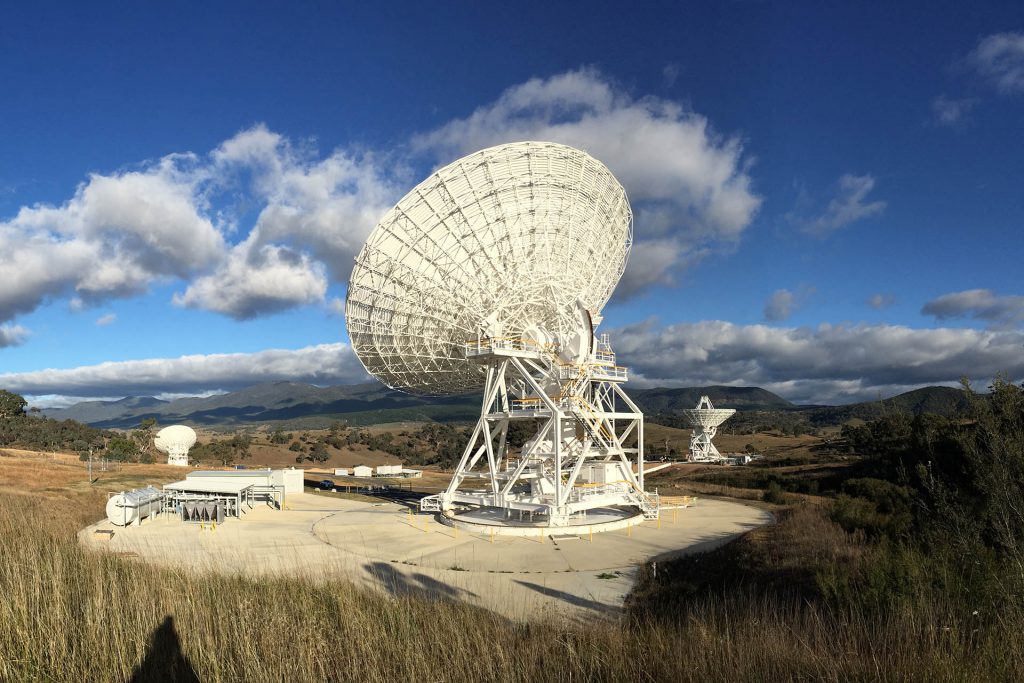
Australia’s space sector is making steady progress towards establishing a sovereign space capability, both for civil and commercial roles and for defence and national security tasks. It’s also continuing to play a crucial role in international collaboration, which includes hosting the NASA deep space communication complex at Tidbinbilla, just outside of Canberra.
The Tidbinbilla facility, part of NASA’s Deep Space Network, is essential for sustaining communications with numerous deep-space interplanetary probes. For example, the site’s largest antenna—the 70-metre DSS-43 dish—is the only one in the southern hemisphere that can communicate with Voyager 2, whose mission has been underway since 1977 and which is now entering interstellar space at a stunning distance of 18 billion kilometres from earth.
With a range of interplanetary missions now underway or due to launch in coming years, Tidbinbilla’s international importance will likely grow. Several probes are already en route to Mars, notably the NASA Mars 2020 Perseverance rover that will land in February 2021 to look for life beneath the Martian surface, and the Hope Mars probe, launched by the United Arab Emirates and currently supported by Tidbinbilla. NASA is also developing the Europa Clipper, a complex probe that will orbit Jupiter’s moon Europa and study the ocean that lies under its frozen surface. Tidbinbilla will support that mission once it is launched, probably in the coming decade.
In terms of crewed spaceflight, the Biden administration is almost certain to sustain, though delay, the NASA Artemis crewed missions to the moon. Following in the footsteps of Honeysuckle Creek and Parkes during the Apollo missions in the 1960s, in the 2020s Tidbinbilla will provide communications support for the next landing of a crew on the moon’s surface.
The facility also supports missions by other national space agencies, including the Japanese Aerospace Exploration Agency. A key current task is providing communications to Japan’s Hayabusa 2 probe, which is heading back to earth after a visit to the asteroid Ryugu. The entry capsule containing a surface sample is due to land at Woomera in South Australia this weekend.
The Tidbinbilla facility thus positions Australia at the top of global cooperation in many space science activities and plays a key role in international engagement, which the Australian Space Agency highlights under its 2019 civil space strategy.
In considering how Australia’s role in space should evolve, the strategy talks about inspiring a future generation of space leaders by engaging the nation and building a future workforce, as well as through ‘moonshot missions’. The strategy alludes to contributing Australian expertise and technology in robotic systems on the lunar surface, perhaps in support of mining operations.
But why limit Australia’s efforts to robotic mining? With the moonshot concept in mind, Australia should seize an opportunity to combine activity in its commercial satellite sector—which is focused on developing small satellites and cubesats at low cost—with the field of space science to extend our international engagement and expand our horizons in space.
One possibility would be for Australia’s space sector, in collaboration with universities, to explore how small satellite technologies and sovereign launch capabilities could support an Australian interplanetary mission. An interplanetary probe, based on small satellite technologies and launched from Australia on an Australian launch vehicle, such as Gilmour Space Technologies’ proposed Eris booster, would place Australia in a select group of countries that have, or are planning, interplanetary missions. It would boost our profile as a major space power internationally and elevate the Australian space sector’s opportunities for the future, particularly for collaborative research in space science.
A key objective of the first such mission should be technology demonstration and experimentation. Most importantly, it should be to prove that Australia can use low-cost small satellite or cubesat technologies and architectures for its own deep-space exploration. Small-satellite- and cubesat-based space probes such as NASAs Capstone project are showing that deep-space missions need not entail huge financial costs or large, complex probes. Australia must embrace this low-cost path as the best approach to extend our profile in space science.
Through experimentation with advanced propulsion technologies such as solar-electric propulsion, Australian space probes could explore the inner solar system alongside those of other nations. As a sign of maturity in our space sector, it’s important that such missions are overseen by the new mission control centre that will be located at the Australian Space Agency’s headquarters in Adelaide.
Successfully demonstrating this technology—and generating a useful scientific return—at a reasonable cost would open up a new area for Australia’s space community to expand into. Rather than just pursuing earth-orbiting satellites, Australia could act as a technological trailblazer for low-cost probes undertaking orbital missions to the moon, Mars, Venus and perhaps nearby asteroids for research that contributes to our understanding of planetary science.
With this goal in mind, the importance of facilities such as Tidbinbilla should grow even more, in turn justifying greater US and Australian investment in expanding them. Additional dish antennas could be built at the Tidbinbilla complex, including for experimenting with advanced spacecraft communication, such as laser optical communications. Other tasks, such as deep-space radar detection and imaging of potentially hazardous near-earth asteroids, could also be pursued from the facility.
Expanding our international collaboration in space should be seen as an important element of our soft power and a means to contribute public goods that promote international cooperation in space. Investing more in new capabilities for facilities such as Tidbinbilla would boost Australia’s importance in international space cooperation.
If Australia’s space community were to consider the possibility of an Australian interplanetary mission through locally developed technologies that could be launched from Australia, this would take our approach to space to the next level, both on the ground and in deep space.

